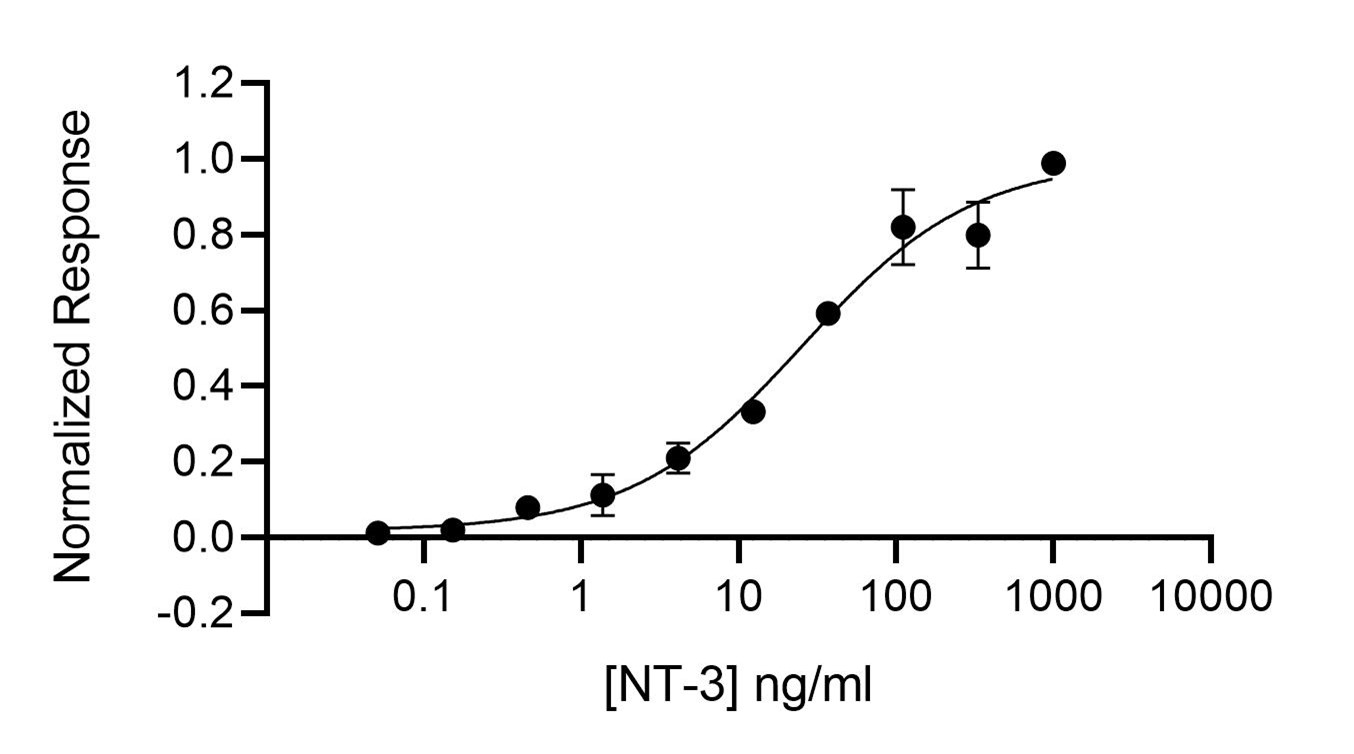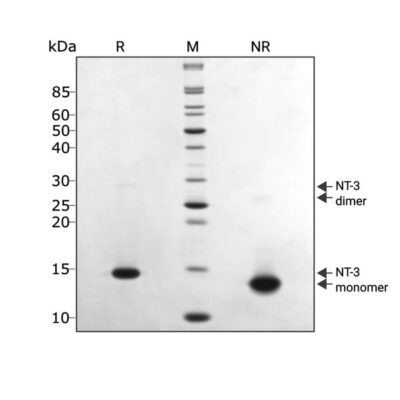Recombinant Human/Mouse/Rat NT-3, Animal-Free Protein
Recombinant Human/Mouse/Rat NT-3, Animal-Free Protein Summary
Product Specifications
Product Datasheets
Carrier Free
CF stands for Carrier Free (CF). We typically add Bovine Serum Albumin (BSA) as a carrier protein to our recombinant proteins. Adding a carrier protein enhances protein stability, increases shelf-life, and allows the recombinant protein to be stored at a more dilute concentration. The carrier free version does not contain BSA.
In general, we advise purchasing the recombinant protein with BSA for use in cell or tissue culture, or as an ELISA standard. In contrast, the carrier free protein is recommended for applications, in which the presence of BSA could interfere.
Qk058
| Stability & Storage: | Store lyophilized protein between -20 and -80 degreesC until the date of expiry. Avoid freeze-thaw cycles. |
Scientific Data
 View Larger
View Larger
NT-3 bioactivity is measured using a luciferase reporter assay in HEK293T cells co-transfected with the TrkA receptor. Cells are treated in triplicate with a serial dilution of NT-3 for 3 hours. Firefly luciferase activity is measured and normalized to the control Renilla luciferase activity.EC50 = 25.4 ng/ml (0.93 nM).
 View Larger
View Larger
Human NT-3 protein (Qk058) migrates mainly as a single band at 13.7 kDa in non-reducing (NR) conditions and upon reduction (R).Purified recombinant protein (3 µg) was resolved using 15% w/v SDS-PAGE in reduced (+ beta -mercaptoethanol, R) and non-reduced (-beta -mercaptoethanol, NR) conditions and stained with Coomassie Brilliant Blue R-250. A faint band visible at 27.3 kDa in NR and R conditions, corresponds to the non-covalently linked NT-3 dimer. No contaminating bands are visible.
Reconstitution Calculator
Background: NT-3
Neurotrophin-3 (NT-3) is a member of the NGF family of neurotrophic factors (also named neurotrophins) that are required for the differentiation and survival of specific neuronal subpopulations in both the central as well as the peripheral nervous systems. The neurotrophin family is comprised of at least four proteins including NGF, BDNF, NT-3, and NT-4/5. These secreted cytokines are synthesized as prepropeptides that are proteolytically processed to generate the mature proteins. All neurotrophins have six conserved cysteine residues that are involved in the formation of three disulfide bonds and all share approximately 55% sequence identity at the amino acid level. Similarly to NGF, bioactive NT-3 is predicted to be a noncovalently linked homodimer. Human NT-3 cDNA encodes a 257 amino acid residue precursor protein with a signal peptide and a proprotein that are cleaved to yield the 119 amino acid residue mature NT-3. The amino acid sequence of mature NT-3 is identical in human, mouse, and rat. NT-3 transcripts have been detected in the cerebellum, hippocampus, placenta, heart, skin, and skeletal muscle. NT-3 primarily activates the TrkC tyrosine kinase receptor. In addition, NT-3 can activate Trk and TrkB kinase receptors in certain cell systems. NT-3 can also bind with low affinity to the low affinity NGF receptor.
Citation for Recombinant Human/Mouse/Rat NT-3, Animal-Free Protein
R&D Systems personnel manually curate a database that contains references using R&D Systems products. The data collected includes not only links to publications in PubMed, but also provides information about sample types, species, and experimental conditions.
1 Citation: Showing 1 - 1
-
A Novel Ex Vivo Model to Study Therapeutic Treatments for Myelin Repair following Ischemic Damage
Authors: Werner, L;Gliem, M;Rychlik, N;Pavic, G;Reiche, L;Kirchhoff, F;Silva Oliveira Junior, M;Gruchot, J;Meuth, SG;Küry, P;Göttle, P;
International journal of molecular sciences
Species: Rat
Sample Types: Whole Cells
Applications: Cell Culture
FAQs
No product specific FAQs exist for this product, however you may
View all Proteins and Enzyme FAQsReviews for Recombinant Human/Mouse/Rat NT-3, Animal-Free Protein
There are currently no reviews for this product. Be the first to review Recombinant Human/Mouse/Rat NT-3, Animal-Free Protein and earn rewards!
Have you used Recombinant Human/Mouse/Rat NT-3, Animal-Free Protein?
Submit a review and receive an Amazon gift card.
$25/€18/£15/$25CAN/¥75 Yuan/¥2500 Yen for a review with an image
$10/€7/£6/$10 CAD/¥70 Yuan/¥1110 Yen for a review without an image


